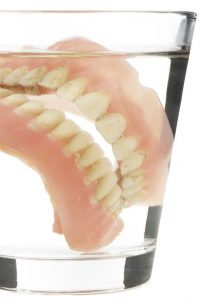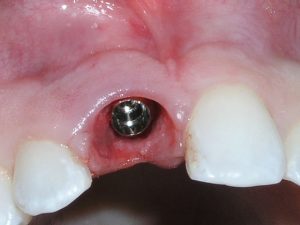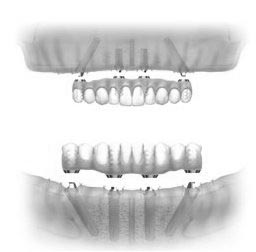Header logo
header top contact widget
Insurance Coverage & Payment Plans
Senior Years Add To Challenges Of Enjoying A Healthy Smile
Posted on Feb 06, 2018 by William J. Claiborne, DDS MS
Every age has its challenges. As a teen, I longed to have more freedom. As a twenty-something, I wanted to feel more established and confident in my career. In my thirties and forties, I craved more downtime as I juggled a jam-packed schedule with a home, children, a periodontal practice, and friends.
With each decade, I think we find ourselves with similar challenges. Now, like others who have entered their ‘mature’ years, health challenges seem to be more prominent in my life.
Although senior age may have its challenges, from an oral health standpoint, today’s senior is in a far better position than that experienced by our grandparents. 
Most of us can recall seeing our grandparents’ dentures soaking in a glass by the bathroom sink each night. Today’s senior knows that keeping their natural teeth all their life is very possible (and highly beneficial to their overall health).
I’d like to address some of the challenges that the senior smile faces today and how they can decrease the risk for developing problems or losing teeth.
• Dry Mouth: The aging process leaves us less, well… supple. It causes our skin to sag, leads to more susceptibility for skin problems, and produces less moisture in our mouths. As saliva production declines, there is less of a rinsing agent to move bacteria and food particles from the mouth. This increases the risk for oral bacteria accumulation. It is no wonder that seniors have a higher incidence of gum disease – over 70 percent for those over the age of 65 (compared to 47.2 percent for ages 30 and over). (https://www.perio.org/consumer/cdc-study.htm)
• Poor Manual Dexterity: The aging process may cause some people to have achy joints or dexterity difficulties. When it becomes difficult to brush and floss thoroughly, the potential for bacteria accumulation in the mouth increases. As oral bacteria amass, the overload can lead to decay and gum disease.
• Tooth Loss: Many people lose one or several teeth before reaching their senior years. This may be due to accidents, health problems or gum disease (the number one cause for adult tooth loss). However, it is important to know that losing a natural tooth sets off a domino effect. Statistics show the tooth most likely to be lost next is a tooth adjacent to the missing area.
• Financial Limitations: Some of us joke about elders rushing to ‘early bird specials’ or sneaking sugar packets into purses, but the truth is, people who are retired must live on tighter budgets. When health coverages are no longer available through one’s employer, managing increased expenses for doctors’ visits, medications and unexpected problems can mean sacrifices in other areas. For some people, they forgo their 6-month dental checkups, assuming that “if nothing hurts, then nothing is wrong.” However, the lack of preventive measures when it comes to oral health can catch up to a senior in other, rather expensive ways.
• Accessibility To Care: For those of us who drive, getting to a dental office for a cleaning or to treat a problem is far simpler than those who no longer drive. When a senior has to recruit a friend or family member to accomplish these needs, the frequency in dental care can take a back seat.
• Diet: Cooking for one or two can mean a rather altered blend of nutritious foods. It may seem so much easier and even more economical to open a can rather than put a pot on to boil. Fresh foods also require more frequent visits to the grocery store. For those who rely on others for transportation, this may lead to greater consumption of processed foods laden in sugar or starchy fillers. This increases the bacteria level in the mouth.
So, how does a senior avoid tooth decay, tooth loss and gum disease? Here are some recommendations:
– Nothing is as effective or as economical as prevention. Be committed to twice-a-day brushing and daily flossing. Brush for at least two minutes each time and finish up by brushing the tongue, where millions of oral bacteria hide. If brushing is difficult, use an electronic toothbrush or wrap the foam from a hair roller around the handle for a better grip. If flossing is awkward, use a water flosser. These are just as effective as flossing and easy to use.
– Although money may be tighter on a retired budget, look at your 6-month dental checkups for the savings they provide. These visits remove plaque and tartar buildup that can lead to cavities and gum disease. Liken these visits to having your vehicle’s oil changed. You don’t have to do it, but it will eventually cost you big-time if you don’t.
– Be conscious of what you eat and how often you eat. Try to steer clear of sweets and carbs, opting for fresh fruits and veggies. Limit snacking or sipping colas over an extended period of time. Remember — every time you eat or drink (other than water), an acid attack begins in your mouth. If you like a sweet treat during the day, have it for dessert after a meal when an acid attack is already underway. This will keep a new one from bombarding your precious tooth enamel with this harsh acid.
– Keep your mouth moist. Drink pure, filtered water throughout the day. This will keep your mouth fresher and hydrates the entire body at the same time. Try to limit things that are drying to the mouth. This includes caffeinated beverages (coffee, tea, hot chocolate) and spicy foods. If you take medications that are drying to the mouth, consider using an over-the-counter oral rinse designed to replenish oral moisture. If you smoke, you have special challenges with drying. Be very conscious of the moistness level in your mouth.
– If you are missing teeth, it is important to replace them with an option that is comfortable, secure and stable. I’ve had patients who avoided dining with friends for years because of unstable dentures. I’ve also had patients who developed health problems because their diet consisted of soft foods that dissolved easily in the mouth. Dental implants restore the ability to eat a healthy diet comfortably and laugh with friends without worry. The investment of implants will last your lifetime and bring you everyday pleasure. I’ve never had a dental implant patient who didn’t say, “It’s the best investment I’ve ever made.” That’s well-worth looking into.
Be a senior who smiles and enjoys the confidence and pleasures of growing older! Call 828-274-9440 to schedule a consultation. During this time, we’ll discuss your individual needs and the options that may be best for you. And, if financial challenges exist, we’ll have our Financial Coordinator discuss easy payment options.
Are Dental Implants Worth The Cost?
Posted on Jan 29, 2018 by William J. Claiborne, DDS MS
As a periodontal specialist, I have advanced training in treating all stages of periodontal (gum) disease as well as in the diagnosis and placement of dental implants.
Over the years, I’ve seen exceptional developments in both areas. As research reveals more about the importance of having good oral health and the ability to bite and chew comfortably and securely, the adult population is taking note.
In some of my prior articles, I’ve addressed the correlation between the bacteria of gum disease and systemic inflammation. I’ve also mentioned the problems – both physiological and psychological – related to missing teeth, and primarily with wearing dentures and partials.
Losing teeth means their tooth roots are no longer held by the jaw bone. Without their presence, the jaw bone lacks the stimulation and nourishment needed to maintain a healthy mass. This leads to bone resorption. Simply put, this term describes a ‘melting away’ process of the bone where tooth roots no longer exist.
Not only do dental implants restore a sturdy, dependable foundation for replacement teeth, they recreate the presence of tooth roots. This halts the process of resorption and helps the jaw bone to retain it’s mass.
Why is the size of the jaw bone important?
When the jaw bone shrinks, the ability to bite and chew comfortably is compromised. The bone is also more susceptible to breaks and fractures. Another problem occurs with changes in facial appearance that are aging far beyond one’s actual years.
For example, as the jaw bone shrinks, facial muscles detach and jowls form. Deep wrinkling occurs around the mouth and the corners of the mouth turn downward, even in a smile. The chin becomes more pointed and moves closer to the nose. The mouth appears ‘sunken in,’ creating a ‘granny look.’
With all the positive aspects of dental implants, what keeps some adults from this ideal tooth replacement option?
In most cases, we find the only deterrent is the cost of implant treatment. Since treatment fees are all ‘up front,’ some people feel the expense is more than they can manage. Yet, there are payment plans that can help break implant fees into affordable monthly payments. Too, I like to remind patients about the life of a dental implant.
When properly selected, placed and maintained, dental implants should last your lifetime. Additionally, you’ll be able to bite and chew the foods you love without worrying about uncomfortable rubbing or embarrassing slips. You’ll also enjoy everyday pleasures, such as speaking, laughing and being close with others.
The American Academy of Implant Dentistry (AAID) also addresses the importance of dental implants from an oral health standpoint (https://www.aaid-implant.org/about-dental-implants/dental-implant-costs-3-things-you-need-to-know/):
“Dental implants may also offer better oral health-related quality of life compared with other tooth replacement options. This is related to the bonding of the implant with your jawbone – it can be more important than you might realize. Yes, it reduces the slipping associated with dentures, but just as importantly, it stimulates healthy bone formation. In contrast, dentures and other non-implant options can lead to bone loss over time as the body senses that the tooth is missing. In addition, while dentures may allow food to wedge in between the gums and the denture itself, dental implants behave like natural teeth.”
Rather than assume dental implants are out of reach monetarily, arrange a consultation appointment to discuss the fees as they would apply to YOUR INDIVIDUAL NEEDS. There are many different types of implants and the one best suited for you may come at less cost than you realize.
I also find that people have misconceptions when it comes to implants. For instance, some assume that an implant is needed for each missing tooth. In fact, one implant can hold a bridge of several teeth and several strategically-placed implants can secure a full arch of teeth.
Let’s discuss your needs and goals according to a process that will enable you to enjoy the advantages of dental implants within a realistic budget. Call 828-274-9440 to schedule a private consultation.
Difference Between Crown-&-Bridge And Dental Implants
Posted on Sep 28, 2017 by William J. Claiborne, DDS MS
When replacing one, two or several teeth in one area, one option is a crown & bridge. For many individuals, it seems most practical to go with the less-expensive option. Yet, there are several reasons you should weigh the advantages of Dental Implants vs. crowns and bridges, which are far more important than ‘perceived’ costs.
A bridge, initially, costs less than Dental Implants. Although the cost of a crown-&-bridge combination seems like ‘the way to go’ when it comes to replacing a tooth or teeth, many people are unaware of the long-term expenses and underlying issues.
Yet, over time, a crown-&-bridge can require upkeep. From root canals to crown replacement to cracked bridges that need replacing, these costs add up, and up and up and…
Let’s look at the differences between Dental Implants and crown-&-bridge other than cost.
Dental Implants are held by the jaw bone, which provides the same foundation as that of natural tooth roots. This means that replacement teeth do not need the support of adjacent, natural teeth that have been crowned to serve to support a bridge. By keeping your natural teeth ‘natural,’ you are able to maintain the integrity of natural tooth structure, giving a strong advantage to your oral health.

An implant serves as a tooth root replacement, held by the jaw bone.
Because Dental Implants use the natural foundation of your jaw bone, they give another advantage to your oral health. Dental Implants integrate with the structure of your bone. They recreate the presence of natural tooth roots and halt the process of bone loss.
Bone loss from missing teeth, or ‘resorption,’ occurs from the lack of stimulation that tooth roots provide to the jaw bone. Through this, they help to prevent the bone loss and gum recession that often accompany bridgework and partials.
Bone loss is a concern since it can place neighboring teeth at risk. As the bone shrinks in the area of missing teeth, the foundation of those teeth is compromised. Odds are, when a tooth is lost, the next one you’ll lose is one adjacent due to this bone loss.
Yet another advantage of Dental Implants? – Their ability to look, feel and function just as natural teeth. Some people prefer to keep the fact that they wear Dental Implants a private issue. With Dental Implants, no one need to ever know you have a ‘third set’ of teeth. Non-removable implant systems allow you to wake up with a smile and brush your implanted teeth along with your natural teeth!
The success rate of Dental Implants is one of the highest implant-in-bone types, including hips and knees. Properly selected, placed and maintained, Dental Implants offer a lifetime solution for tooth replacement. As a Periodontal specialist, I provide specific expertise in the diagnosis and placement of Dental Implants. This gives our patients an edge — specific knowledge, training and skills so they can enjoy teeth that look and feel just like their own (because they are!).
Consider Dental Implants based on the long-term advantages, for optimal oral health as well as a wise investment that will last your lifetime. Call (828) 274-9440 for a consultation to discuss your needs.
Different Implant Designs For Different Needs
Posted on May 22, 2017 by William J. Claiborne, DDS MS
As a dental specialist with advanced skills in the diagnosis and placement of Dental Implants, I enjoy staying on top of the latest techniques, technology and materials. Over the years, I have been especially excited to provide our patients with the advancements that make implant dentistry such an ideal option in tooth replacement.
Today’s implant dentistry is successful, safe, dependable and often immediate. As the doctor who places the implants, having a role in restoring a patient’s ability to bite, chew, speak and laugh has been a major highlight in a rewarding career.
One of the reasons for the high success rate of Dental Implants is in the design of different systems. For decades, Implant designs have been fine-tuned so various systems are able to accommodate specific challenges and preferences. In addition to being more affordable than ever, implant systems are now available for nearly every situation, including:
Implants Supporting Non-Removable Teeth – For some, removable teeth attached to implants were too similar to the denture they had (and detested). Even though these removable replacement teeth are firmly secured to the implants, most individuals want teeth that do not come out. However, some of the more affordable systems have been those that support removable teeth. Now, an implant system known as All-On
-4 is able to support non-removable teeth using just 4 strategically-placed implants. By positioning the implanted portions at unique angles, the biting and chewing forces are distributed evenly among fewer implants. Another advantage of this system is its ability to be placed in minimal bone. Long-time denture wearers are often challenged because of severe bone loss. Having insufficient bone mass to support Implants has prevented some people from having implants or required bone rebuilding procedures prior to implant placement. The All-On-4 implant system is able to overcome this obstacle.
Traditional Dental Implants – Still today, the ‘gold standard’ for most implant treatment requires several stages. Placement of the implants is performed first. For several months after, the bone goes through a process known as ‘osseo-integration.’ This takes place over a 3-6 month period and secures the implant in the upper or lower jaw bone, similar to natural tooth roots. Once secured, the implant sites are uncovered and a post is positioned inside to which the replacement teeth are secured. During osseointegration, however, patients are able to comfortably wear their denture or partial.
Fast-Track Dental Implants – As the design of implant systems have advanced with the involvement of computerized technology, implant placement and teeth attachment can often be completed in less time than that required by traditional implants. Having the ability to pre-select ideal placement positions prior means that, in some cases, immediate attachment of teeth can occur. While this option isn’t appropriate for everyone, certain patients are, indeed, excellent candidates. This is why it is important to have an experienced and highly-trained doctor coordinate your diagnosis and placement. When your individual needs are carefully assessed, a successful outcome has greater potential with the foundation of a proper diagnosis and implant selection.
Dental Implants are the closest thing to the natural teeth you once had. They are also designed to last a lifetime, making them an excellent investment. The type of implant system best suited to your needs will be discussed after an examination and review of Panorex (jaw-to-jaw) imaging.
Let’s discuss the implant system that is best for your needs and goals during a private consultation appointment. We’ll also discuss comfort options, including Oral and I.V. Sedation. Call 828-274-9440.
Recent Posts
Categories
Archives
- September 2024
- August 2024
- July 2024
- June 2024
- May 2024
- April 2024
- March 2024
- February 2024
- January 2024
- December 2023
- November 2023
- October 2023
- September 2023
- August 2023
- July 2023
- June 2023
- May 2023
- April 2023
- March 2023
- February 2023
- January 2023
- December 2022
- November 2022
- October 2022
- September 2022
- August 2022
- July 2022
- June 2022
- May 2022
- April 2022
- March 2022
- February 2022
- January 2022
- December 2021
- November 2021
- October 2021
- September 2021
- August 2021
- July 2021
- June 2021
- May 2021
- April 2021
- March 2021
- February 2021
- January 2021
- December 2020
- November 2020
- October 2020
- September 2020
- August 2020
- July 2020
- June 2020
- May 2020
- April 2020
- March 2020
- February 2020
- January 2020
- December 2019
- November 2019
- October 2019
- September 2019
- August 2019
- July 2019
- June 2019
- May 2019
- April 2019
- March 2019
- February 2019
- January 2019
- December 2018
- November 2018
- October 2018
- September 2018
- August 2018
- July 2018
- June 2018
- May 2018
- April 2018
- March 2018
- February 2018
- January 2018
- December 2017
- November 2017
- October 2017
- September 2017
- August 2017
- July 2017
- June 2017
- May 2017
- April 2017
- March 2017
- February 2017
- January 2017
- December 2016
- November 2016
- October 2016
- September 2016
- August 2016
- July 2016
- June 2016
- May 2016
- April 2016
- March 2016
- February 2016
- January 2016
- December 2015
- November 2015
- October 2015
- September 2015
- August 2015
- July 2015
- June 2015
- May 2015
- April 2015
- March 2015
- February 2015
- January 2015
- December 2014
- November 2014
- October 2014
- September 2014
- August 2014
- July 2014
- June 2014
- May 2014
- April 2014
- March 2014
- February 2014
- January 2014
- December 2013
- November 2013
- October 2013
- September 2013
- August 2013
- July 2013
- June 2013
- May 2013
- April 2013
- March 2013
- February 2013
- January 2013
- December 2012
- November 2012
- October 2012
- September 2012
- August 2012
- July 2012
- June 2012



